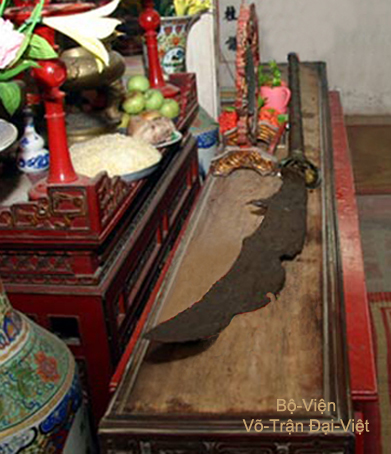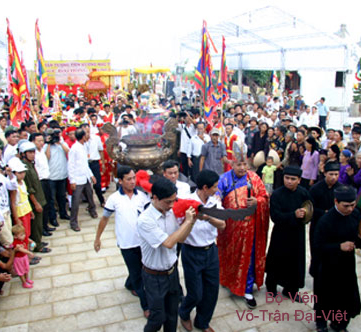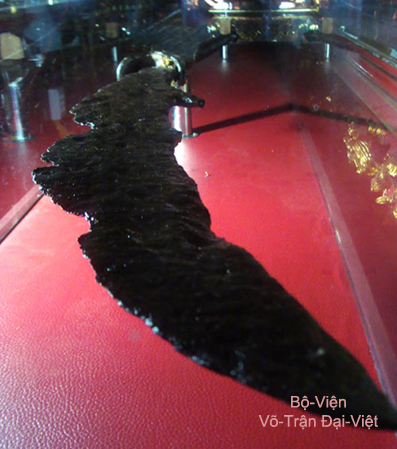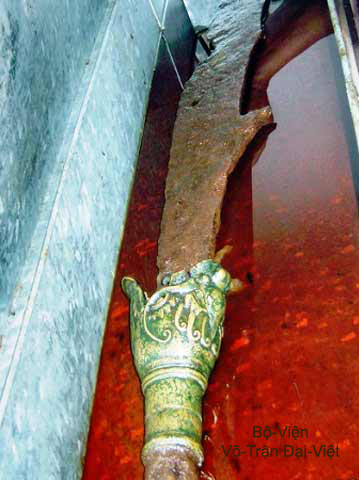II.
THE MEDIEVAL WEAPONS
3 - The Pole-Arms
THE VOUGE of CAVALRY
SIÊU-ĐAO
超 刀
The «Vouge - Siêu-Đao » wielding concerns the using method of « Supreme Sabre - Siêu-Ðao » (超 刀), often shortly called «Siêu».
«Vouge - Siêu-Đao» has been often named «The General in Chief of all Armies - Bá Binh Chi Súy» (百 兵 之 帥) by comparison with a Generalissimo in the middle of warriors on battle fields.
Actually it exists stil dpersons who call erroneously the « Vouge - Siêu-Đao » (超 刀) by « Grand Sabre - Ðại-Ðao » (大 刀) according to the appellation from Chineses.
The « Vouge - Siêu-Đao » (超 刀) is indeed a kind of Sabre with a large blade holding an edged dorsal hook and fixed to an one metre and more long shaft of a Pole-Arm for wielding with two hands, havind a 20cm long hilt behing a garde and inherent to the category of weapons used on horse ; while the Grand Sabre - Ðại-Ðao (大 刀) is a kind of Sabre with a large blade devoid of back hook - called Scimitar - owning a hilt much shorter, often used for fighting on foot (Cf. the article concerning Discussion About the Scimitar).
When the « Vouge - Siêu-Đao » doesn't holding a guard but owns a Dragon Head whom mouth is holding the blade, it's called « Long Ðao » ( 龍 刀).
In verity, the « Long Ðao » ( 龍 刀) Vouge appeared very long ago before the « Siêu-Ðao » (超 刀) Vouge, during the Bronze Period, designed with the raised rounding point bending backward.
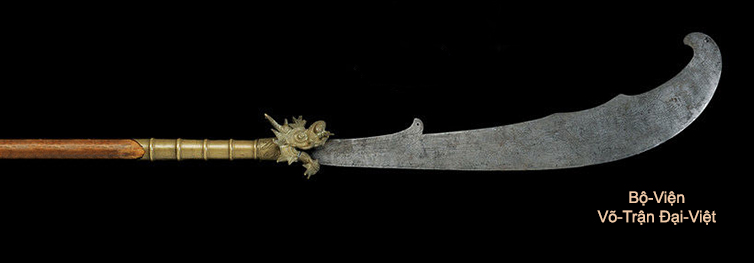
« Long-Đao Vouge from Đại-Việt » designed with a Dragon-Son Head called Nhai-Xải 捱 眥 (the 7th Son of the Dragon)
having a big nose and a short jaw biting the Blade, constructed according to the model of « Antique Bronze Long-Đao »
and supplied with a Hook placed far away the Blade end.
- Đại-Việt - 19th century -
(Photo Credit : Alain Trương)
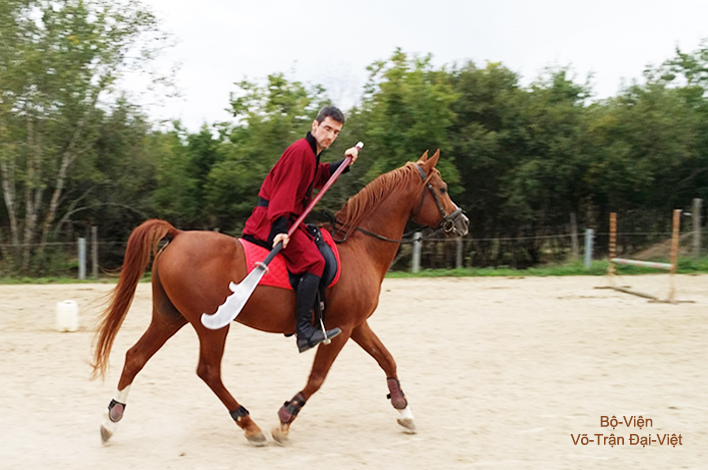
Martial-Student from Võ-Trận Đại-Việt Bình-Định Sa-Long-Cương Academy was wielding the « Antique Siêu-Đao Vouge »,
designed according to the model of « Antique Bronze Long-Đao Vouge », reconstructed in steel for the training on battle horse.
Vouge « Long-Đao » of King Mạc-Đăng-Dung (1483-1541) |
Procession of King Mạc-Đăng-Dung's Vouge « Long-Đao ».
|
Vouge « Long-Đao » of King Mạc-Đăng-Dung (1483-1541), |
Vouge « Long-Đao » of King Mạc-Đăng-Dung (1483-1541)
|
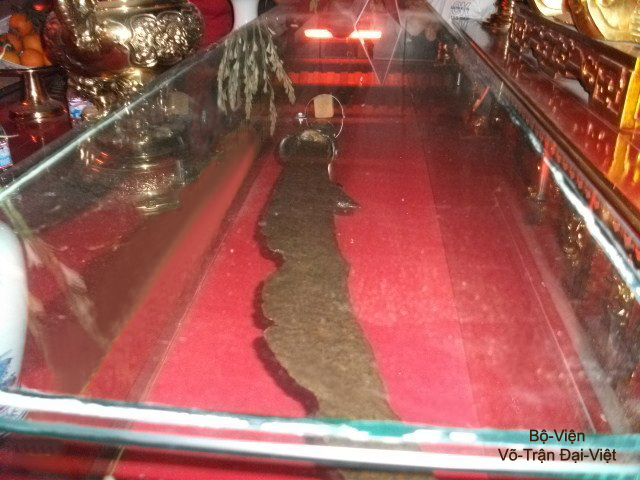
Vouge « Long-Đao » of King Mạc-Đăng-Dung (1483-1541) from MẠC Dynasty, weighing about 30 kg
( still weighing up 25,6 kg after being rusted and damaged in the earth during almost all a century )
- Commemoration Temple of MẠC Dynasty in Hamlet of Cổ-Trai, Village of Ngũ-Đoan -
Prefecture of Kiến-Thụy, Hải-Phòng City, Việt-Nam.
( Photo Credit : VS Nguyễn Phi Long - BĐ SLC VN )
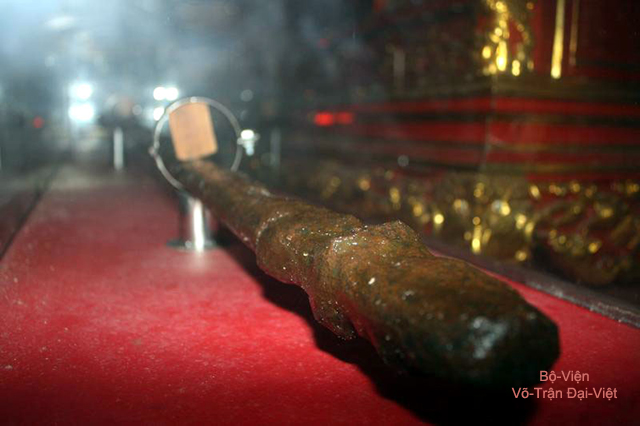
Heel and Vougehandle from Vouge « Long-Đao » of King Mạc-Đăng-Dung (1483-1541) from MẠC Dynasty
- Commemoration Temple of MẠC Dynasty in Hamlet of Cổ-Trai, Village of Ngũ-Đoan -
Prefecture of Kiến-Thụy, Hải-Phòng City, Việt-Nam.
( Photo Credit : VS Nguyễn Phi Long - BĐ SLC VN )
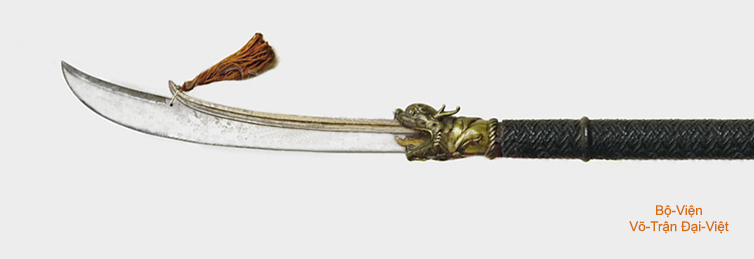
Distinguishing « Long-Đao Vouge » from Đại-Việt,
designed with a Dragon-Son
(the 7th Son of the Dragon) Nhai-Xải 捱 眥) Headed Guard
(Sold out at foreign country
under the erroneous name "Halberd from China or Thailand")
- LÊ-TRỊNH Dynasties (1545-1787) Period -
(Photo Credit : ashokaarts.com)
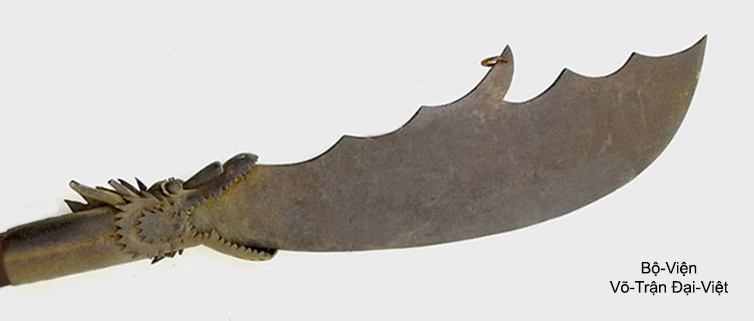
« Long-Đao Vouge from China » designed with long jaw Dragon Headed of Crocodile specie (Giao-Long)
biting the large Blade
supplied with a Hook placed near by the Vouge end.
- China - 19th century -
(Photo Credit : ashokaarts.com)
At MING Period (1368 - 1644), the « Vouge - Siêu-Đao », that on the blade was engraved a Dragon, called « Sabre with Blue-Green Dragon Settling on the Crescent-Moon Blade - Thanh Long Yển Nguyệt Ðao » (青 龍 偃 月 刀), often briefly called « Thanh-Long Ðao » (青 龍 刀) or still, « Sabre of Quan - Quan-Ðao » ( 關 刀)», i.e. the « Sabre with Blue-Green Dragon » of Saint Quan-Vũ (Kuan-Yu - 關 羽) fom Warring States Period (220 Av. JC - 280 Ap. JC). As this latter liked to read the Book of Springs and Autumns from Confucius, so his « Sabre with Blue-Green Dragon » was also called « Great Sabre of Springs and Autumns - Xuân-Thu Ðại-Ðao » (春 秋 大 刀) by Chineses.
At QING Period (1644 - 1912), the « Vouge - Siêu-Đao » was combinated with « Vouge - Long-Đao » .
The typical exemple was the « Vouge Siêu-Đao » of QING's Generalissimo Ngô Tam Quế - Wu San-Kuei (1612~1678), curently exposed at Côn-Minh (Kunming) City Museum, province of Vân-Nam (Yunnan), in China :
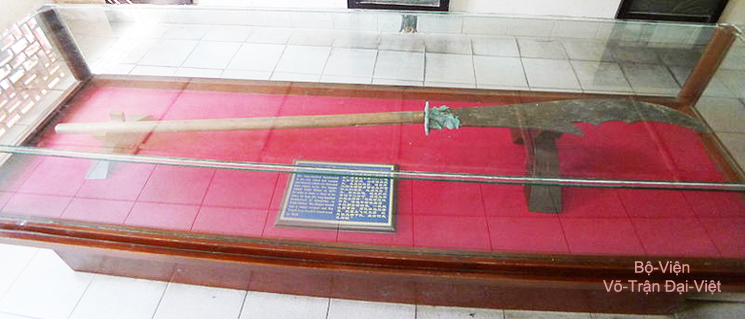
Vouge « Siêu-Đao combinated with Long-Đao » of Generalissimo Ngô Tam Quế 吳三桂
( Wu San-Kuei - 1612~1678 ) from THANH (QING) Dynasty,
weighing up about 20 kg ( the original Vougehandle holding a tip was missing
and replacing with a simple wooden Vougehandle )
- Kunming City Museum, in Yunnan - China -
( Photo Credit : nghiencuulichsu.com )
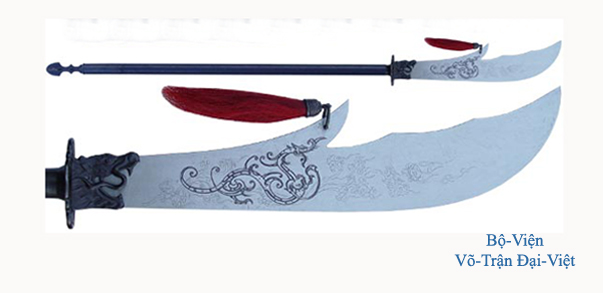
Vouge « Siêu-Đao combinated with Long-Đao » reconstructed
for the training in Martial Arts Drill Halls.
(Photo Credit : Wing Lam Enterprises)
When we are talking about « Vouge - Siêu-Đao », we must talk about illustrious Generals of Đại-Việt who was extremely skilled at this « Vouge - Siêu-Đao » wielding, among them the Grand-Generalissimo Lý-Thướng-Kiệt under LÝ Dynasty (1010-1225), and the Illustrious-Generalissimo Phạm-Ngũ-Lão under TRẦN Dynasty (1225-1400).
We must also talk about the one of courageous General Lê-Đại-Cang of Tây-Sơn Dynasty (1788-1802), the man who has mastered cambodian rebels and pacified the Western City Commandery (Tây -Thành) and above all we must talk about famous Three « Vouges - Siêu-Đao » at Tây-Sơn Period (1788-1802), these are :
1 - «Ô-Long-Ðao» of Emperor Quang-Trung Nguyễn-Huệ ;
2 - «Huỳnh-Long-Ðao» of illustrious Generalissimo Trần-Quang-Diệu ;
3 - «Xích-Long-Ðao» of illustrious Generalissimo Lê-Sĩ-Hoàng.
(To be continued...)
Committee of TRỊNH Quang Thắng |
Copyright © 2004 - 2017 by ACFDV - All rights reserved.
